Construction Project Management: Project Planning & Control Methods
VerifiedAdded on 2023/06/13
|12
|3025
|487
Report
AI Summary
This report provides an in-depth analysis of construction project management, focusing on the Triple Constraint Model (time, cost, and scope) and its strengths and limitations. It discusses planning methods like Zero-Based Budgeting and Cost Breakdown Structure, as well as control methods such as S-curves and Earned Value Management, to manage the constraints of the Iron Triangle. The report also includes a case study on water projects in Kakamega County, Kenya, illustrating the practical application of the Triple Constraint Model and its impact on project success. The Earned Value method's strengths and weaknesses are discussed, highlighting its role in comparing actual versus approximated costs, estimating project performance factors, and maintaining objectivity throughout the project lifecycle. Desklib offers a platform to access similar solved assignments and study tools.
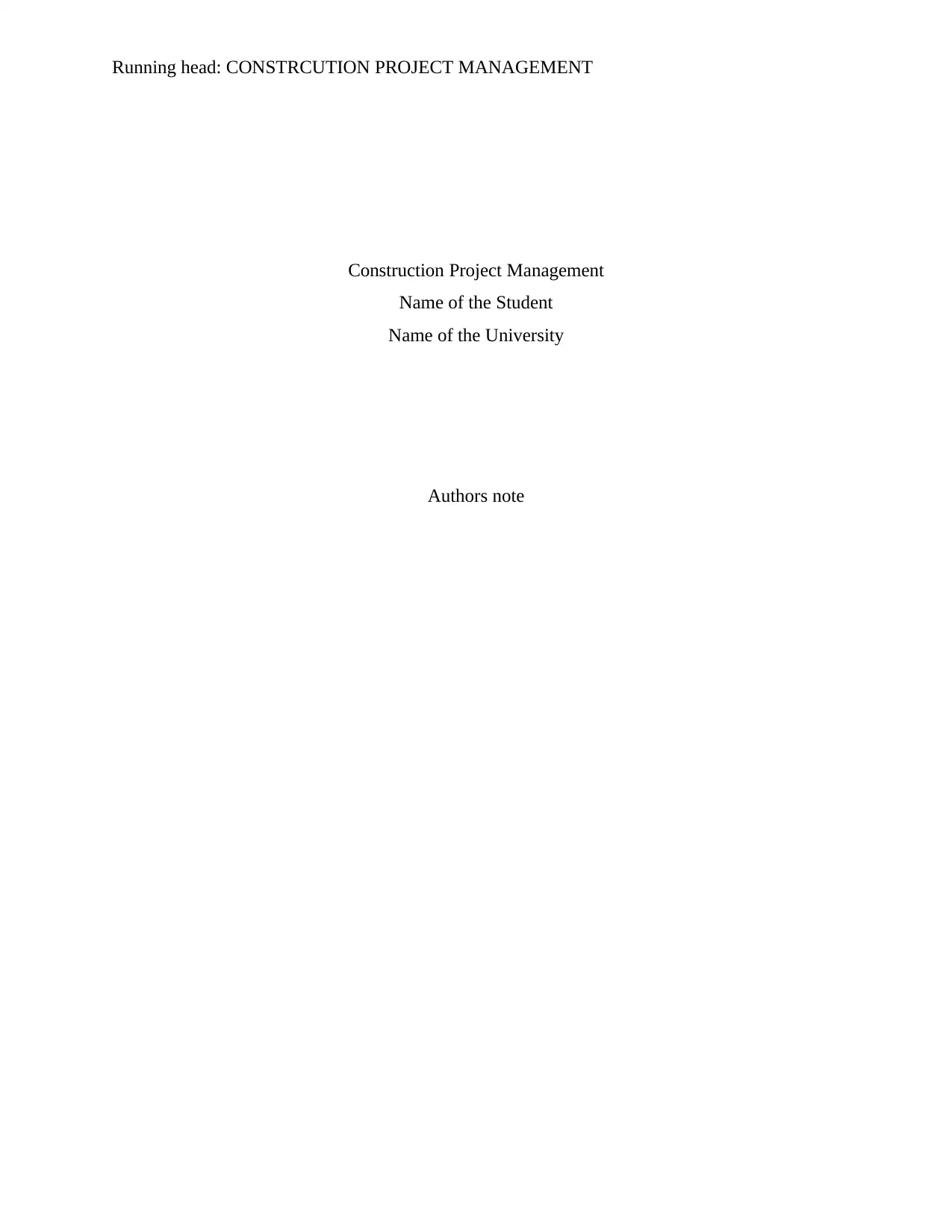
Running head: CONSTRCUTION PROJECT MANAGEMENT
Construction Project Management
Name of the Student
Name of the University
Authors note
Construction Project Management
Name of the Student
Name of the University
Authors note
Paraphrase This Document
Need a fresh take? Get an instant paraphrase of this document with our AI Paraphraser
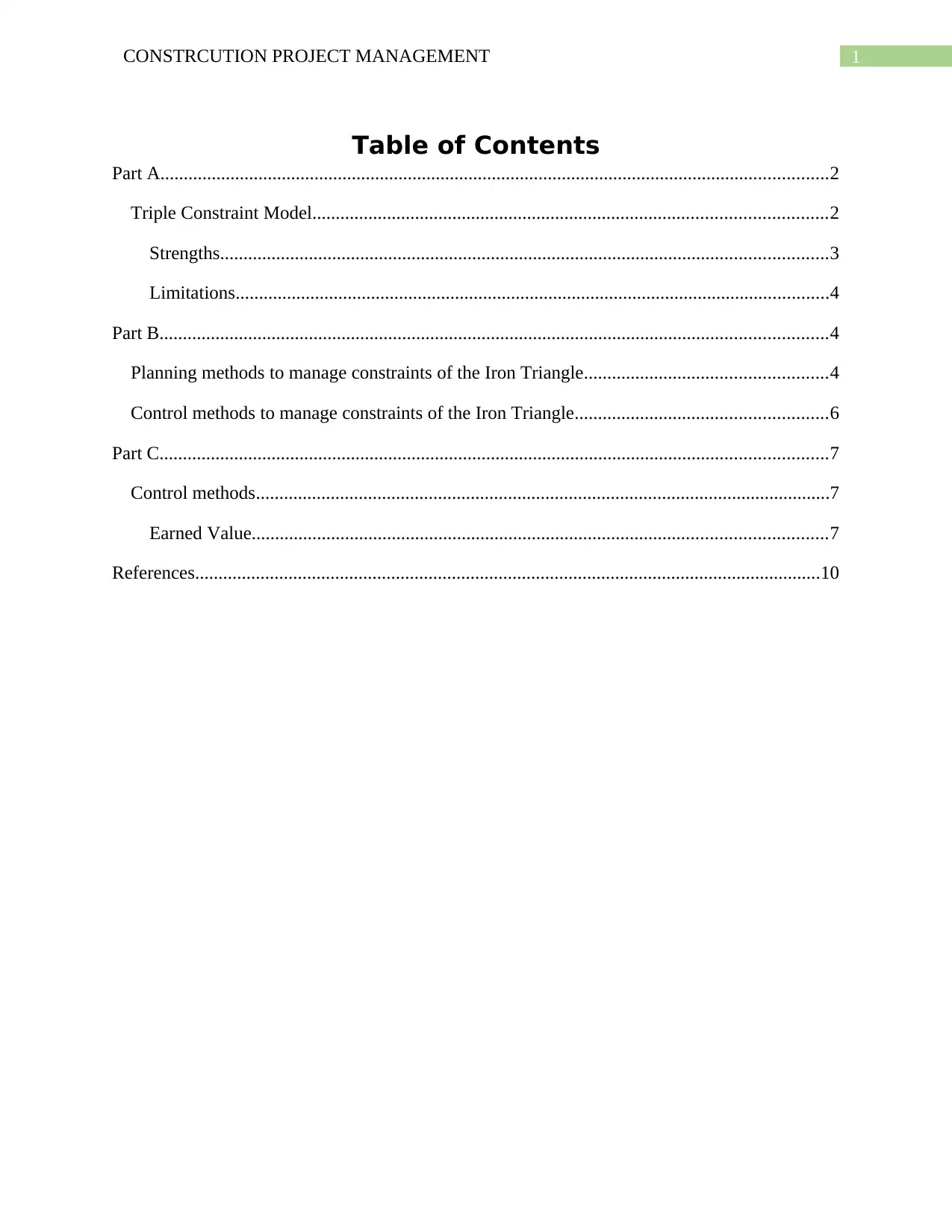
1CONSTRCUTION PROJECT MANAGEMENT
Table of Contents
Part A...............................................................................................................................................2
Triple Constraint Model..............................................................................................................2
Strengths..................................................................................................................................3
Limitations...............................................................................................................................4
Part B...............................................................................................................................................4
Planning methods to manage constraints of the Iron Triangle....................................................4
Control methods to manage constraints of the Iron Triangle......................................................6
Part C...............................................................................................................................................7
Control methods...........................................................................................................................7
Earned Value...........................................................................................................................7
References......................................................................................................................................10
Table of Contents
Part A...............................................................................................................................................2
Triple Constraint Model..............................................................................................................2
Strengths..................................................................................................................................3
Limitations...............................................................................................................................4
Part B...............................................................................................................................................4
Planning methods to manage constraints of the Iron Triangle....................................................4
Control methods to manage constraints of the Iron Triangle......................................................6
Part C...............................................................................................................................................7
Control methods...........................................................................................................................7
Earned Value...........................................................................................................................7
References......................................................................................................................................10
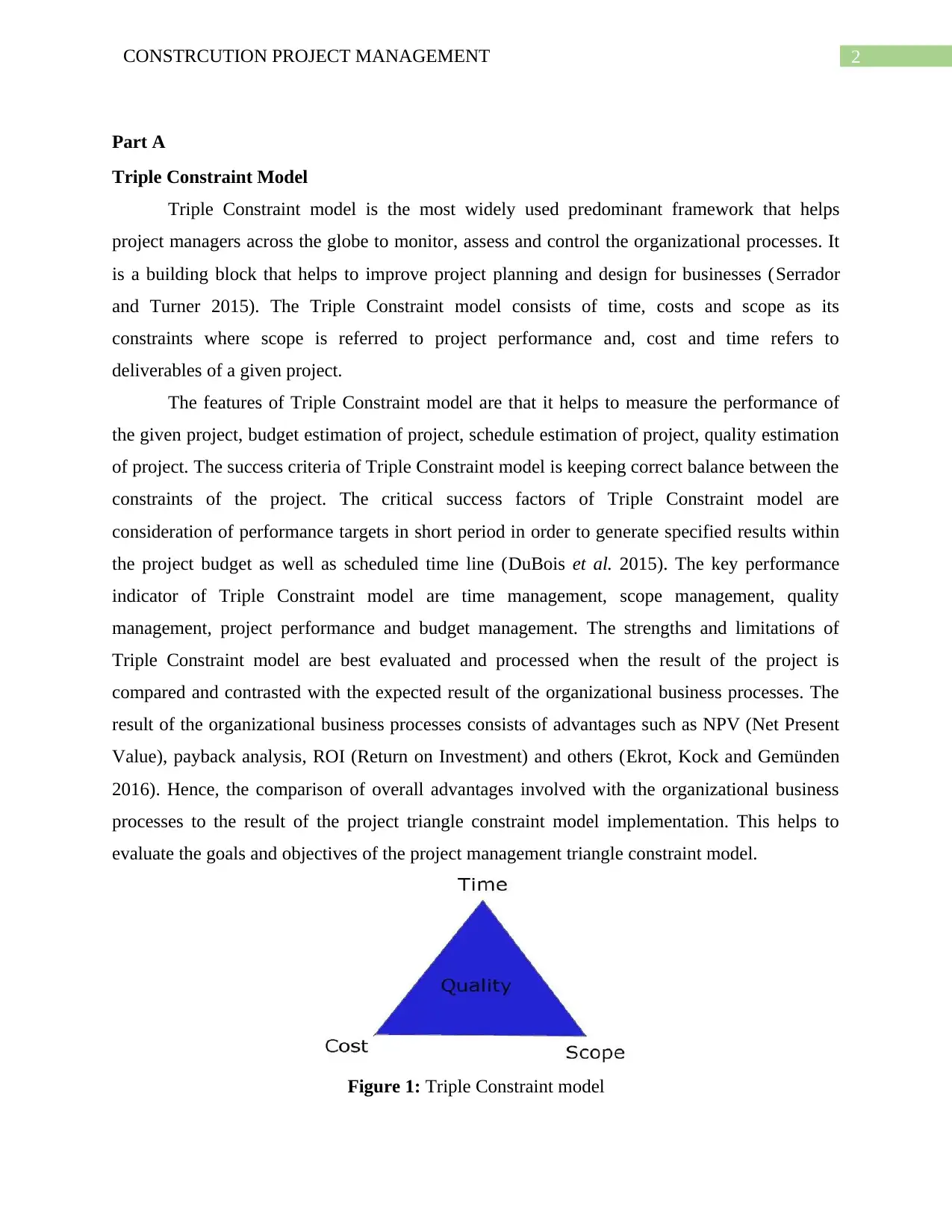
2CONSTRCUTION PROJECT MANAGEMENT
Part A
Triple Constraint Model
Triple Constraint model is the most widely used predominant framework that helps
project managers across the globe to monitor, assess and control the organizational processes. It
is a building block that helps to improve project planning and design for businesses (Serrador
and Turner 2015). The Triple Constraint model consists of time, costs and scope as its
constraints where scope is referred to project performance and, cost and time refers to
deliverables of a given project.
The features of Triple Constraint model are that it helps to measure the performance of
the given project, budget estimation of project, schedule estimation of project, quality estimation
of project. The success criteria of Triple Constraint model is keeping correct balance between the
constraints of the project. The critical success factors of Triple Constraint model are
consideration of performance targets in short period in order to generate specified results within
the project budget as well as scheduled time line (DuBois et al. 2015). The key performance
indicator of Triple Constraint model are time management, scope management, quality
management, project performance and budget management. The strengths and limitations of
Triple Constraint model are best evaluated and processed when the result of the project is
compared and contrasted with the expected result of the organizational business processes. The
result of the organizational business processes consists of advantages such as NPV (Net Present
Value), payback analysis, ROI (Return on Investment) and others (Ekrot, Kock and Gemünden
2016). Hence, the comparison of overall advantages involved with the organizational business
processes to the result of the project triangle constraint model implementation. This helps to
evaluate the goals and objectives of the project management triangle constraint model.
Figure 1: Triple Constraint model
Part A
Triple Constraint Model
Triple Constraint model is the most widely used predominant framework that helps
project managers across the globe to monitor, assess and control the organizational processes. It
is a building block that helps to improve project planning and design for businesses (Serrador
and Turner 2015). The Triple Constraint model consists of time, costs and scope as its
constraints where scope is referred to project performance and, cost and time refers to
deliverables of a given project.
The features of Triple Constraint model are that it helps to measure the performance of
the given project, budget estimation of project, schedule estimation of project, quality estimation
of project. The success criteria of Triple Constraint model is keeping correct balance between the
constraints of the project. The critical success factors of Triple Constraint model are
consideration of performance targets in short period in order to generate specified results within
the project budget as well as scheduled time line (DuBois et al. 2015). The key performance
indicator of Triple Constraint model are time management, scope management, quality
management, project performance and budget management. The strengths and limitations of
Triple Constraint model are best evaluated and processed when the result of the project is
compared and contrasted with the expected result of the organizational business processes. The
result of the organizational business processes consists of advantages such as NPV (Net Present
Value), payback analysis, ROI (Return on Investment) and others (Ekrot, Kock and Gemünden
2016). Hence, the comparison of overall advantages involved with the organizational business
processes to the result of the project triangle constraint model implementation. This helps to
evaluate the goals and objectives of the project management triangle constraint model.
Figure 1: Triple Constraint model
⊘ This is a preview!⊘
Do you want full access?
Subscribe today to unlock all pages.

Trusted by 1+ million students worldwide
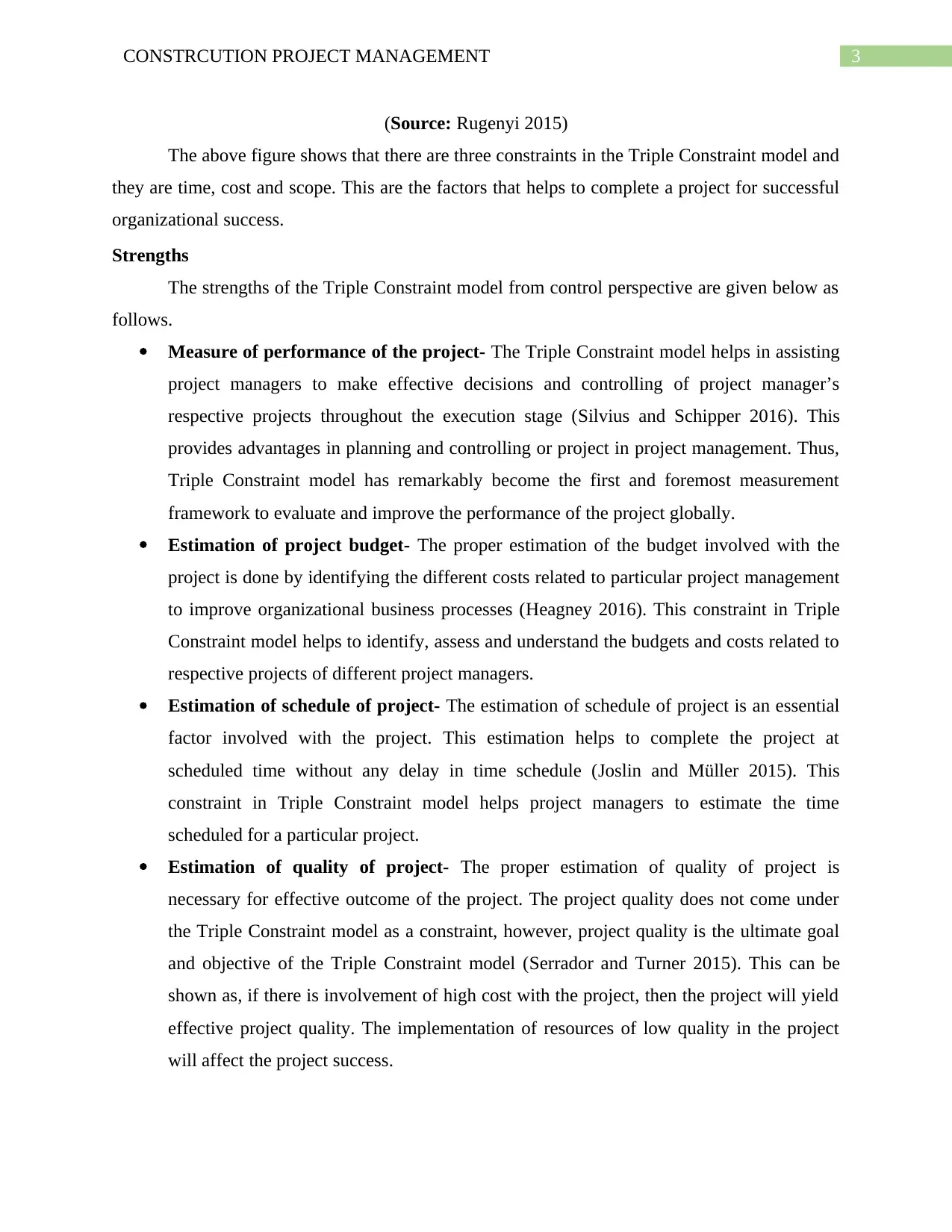
3CONSTRCUTION PROJECT MANAGEMENT
(Source: Rugenyi 2015)
The above figure shows that there are three constraints in the Triple Constraint model and
they are time, cost and scope. This are the factors that helps to complete a project for successful
organizational success.
Strengths
The strengths of the Triple Constraint model from control perspective are given below as
follows.
Measure of performance of the project- The Triple Constraint model helps in assisting
project managers to make effective decisions and controlling of project manager’s
respective projects throughout the execution stage (Silvius and Schipper 2016). This
provides advantages in planning and controlling or project in project management. Thus,
Triple Constraint model has remarkably become the first and foremost measurement
framework to evaluate and improve the performance of the project globally.
Estimation of project budget- The proper estimation of the budget involved with the
project is done by identifying the different costs related to particular project management
to improve organizational business processes (Heagney 2016). This constraint in Triple
Constraint model helps to identify, assess and understand the budgets and costs related to
respective projects of different project managers.
Estimation of schedule of project- The estimation of schedule of project is an essential
factor involved with the project. This estimation helps to complete the project at
scheduled time without any delay in time schedule (Joslin and Müller 2015). This
constraint in Triple Constraint model helps project managers to estimate the time
scheduled for a particular project.
Estimation of quality of project- The proper estimation of quality of project is
necessary for effective outcome of the project. The project quality does not come under
the Triple Constraint model as a constraint, however, project quality is the ultimate goal
and objective of the Triple Constraint model (Serrador and Turner 2015). This can be
shown as, if there is involvement of high cost with the project, then the project will yield
effective project quality. The implementation of resources of low quality in the project
will affect the project success.
(Source: Rugenyi 2015)
The above figure shows that there are three constraints in the Triple Constraint model and
they are time, cost and scope. This are the factors that helps to complete a project for successful
organizational success.
Strengths
The strengths of the Triple Constraint model from control perspective are given below as
follows.
Measure of performance of the project- The Triple Constraint model helps in assisting
project managers to make effective decisions and controlling of project manager’s
respective projects throughout the execution stage (Silvius and Schipper 2016). This
provides advantages in planning and controlling or project in project management. Thus,
Triple Constraint model has remarkably become the first and foremost measurement
framework to evaluate and improve the performance of the project globally.
Estimation of project budget- The proper estimation of the budget involved with the
project is done by identifying the different costs related to particular project management
to improve organizational business processes (Heagney 2016). This constraint in Triple
Constraint model helps to identify, assess and understand the budgets and costs related to
respective projects of different project managers.
Estimation of schedule of project- The estimation of schedule of project is an essential
factor involved with the project. This estimation helps to complete the project at
scheduled time without any delay in time schedule (Joslin and Müller 2015). This
constraint in Triple Constraint model helps project managers to estimate the time
scheduled for a particular project.
Estimation of quality of project- The proper estimation of quality of project is
necessary for effective outcome of the project. The project quality does not come under
the Triple Constraint model as a constraint, however, project quality is the ultimate goal
and objective of the Triple Constraint model (Serrador and Turner 2015). This can be
shown as, if there is involvement of high cost with the project, then the project will yield
effective project quality. The implementation of resources of low quality in the project
will affect the project success.
Paraphrase This Document
Need a fresh take? Get an instant paraphrase of this document with our AI Paraphraser
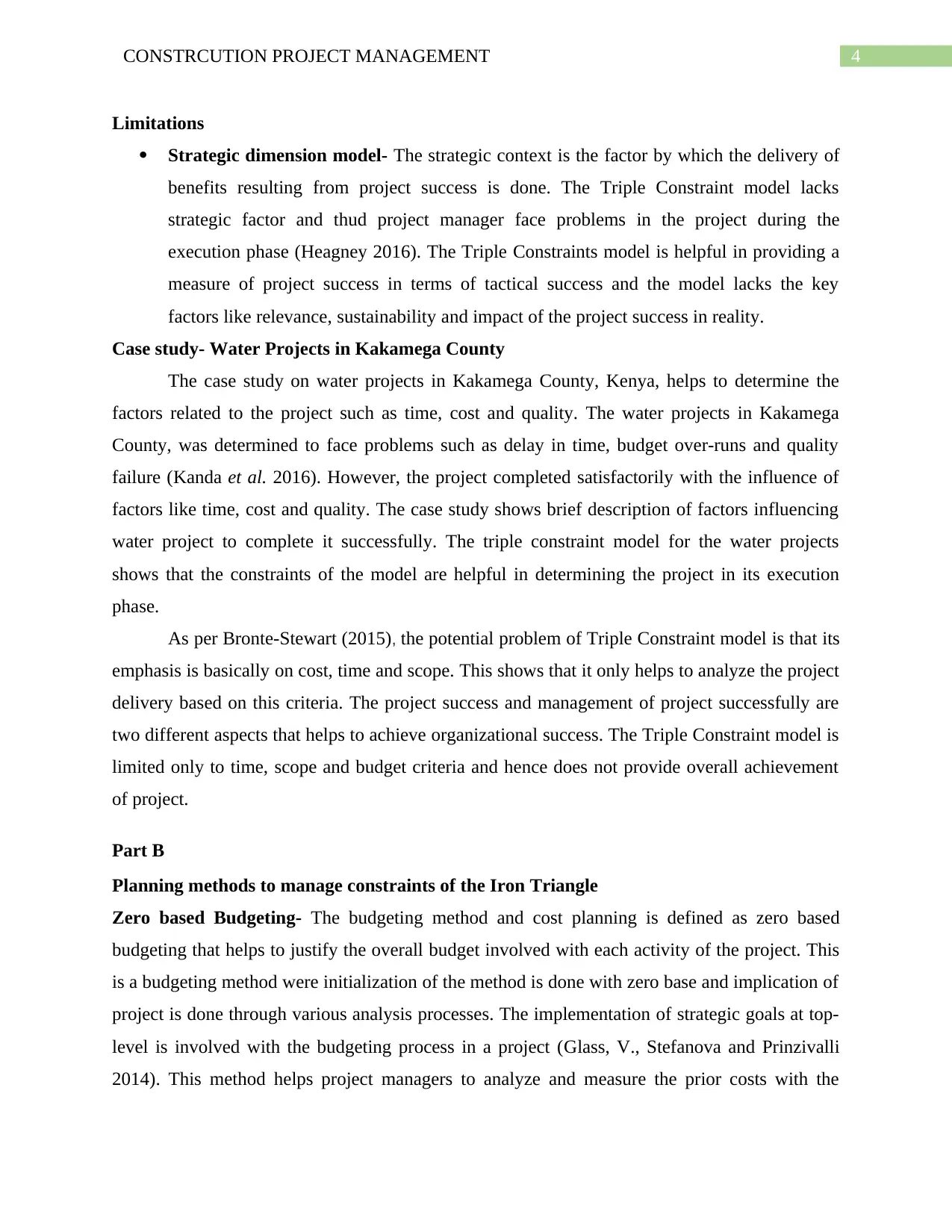
4CONSTRCUTION PROJECT MANAGEMENT
Limitations
Strategic dimension model- The strategic context is the factor by which the delivery of
benefits resulting from project success is done. The Triple Constraint model lacks
strategic factor and thud project manager face problems in the project during the
execution phase (Heagney 2016). The Triple Constraints model is helpful in providing a
measure of project success in terms of tactical success and the model lacks the key
factors like relevance, sustainability and impact of the project success in reality.
Case study- Water Projects in Kakamega County
The case study on water projects in Kakamega County, Kenya, helps to determine the
factors related to the project such as time, cost and quality. The water projects in Kakamega
County, was determined to face problems such as delay in time, budget over-runs and quality
failure (Kanda et al. 2016). However, the project completed satisfactorily with the influence of
factors like time, cost and quality. The case study shows brief description of factors influencing
water project to complete it successfully. The triple constraint model for the water projects
shows that the constraints of the model are helpful in determining the project in its execution
phase.
As per Bronte-Stewart (2015), the potential problem of Triple Constraint model is that its
emphasis is basically on cost, time and scope. This shows that it only helps to analyze the project
delivery based on this criteria. The project success and management of project successfully are
two different aspects that helps to achieve organizational success. The Triple Constraint model is
limited only to time, scope and budget criteria and hence does not provide overall achievement
of project.
Part B
Planning methods to manage constraints of the Iron Triangle
Zero based Budgeting- The budgeting method and cost planning is defined as zero based
budgeting that helps to justify the overall budget involved with each activity of the project. This
is a budgeting method were initialization of the method is done with zero base and implication of
project is done through various analysis processes. The implementation of strategic goals at top-
level is involved with the budgeting process in a project (Glass, V., Stefanova and Prinzivalli
2014). This method helps project managers to analyze and measure the prior costs with the
Limitations
Strategic dimension model- The strategic context is the factor by which the delivery of
benefits resulting from project success is done. The Triple Constraint model lacks
strategic factor and thud project manager face problems in the project during the
execution phase (Heagney 2016). The Triple Constraints model is helpful in providing a
measure of project success in terms of tactical success and the model lacks the key
factors like relevance, sustainability and impact of the project success in reality.
Case study- Water Projects in Kakamega County
The case study on water projects in Kakamega County, Kenya, helps to determine the
factors related to the project such as time, cost and quality. The water projects in Kakamega
County, was determined to face problems such as delay in time, budget over-runs and quality
failure (Kanda et al. 2016). However, the project completed satisfactorily with the influence of
factors like time, cost and quality. The case study shows brief description of factors influencing
water project to complete it successfully. The triple constraint model for the water projects
shows that the constraints of the model are helpful in determining the project in its execution
phase.
As per Bronte-Stewart (2015), the potential problem of Triple Constraint model is that its
emphasis is basically on cost, time and scope. This shows that it only helps to analyze the project
delivery based on this criteria. The project success and management of project successfully are
two different aspects that helps to achieve organizational success. The Triple Constraint model is
limited only to time, scope and budget criteria and hence does not provide overall achievement
of project.
Part B
Planning methods to manage constraints of the Iron Triangle
Zero based Budgeting- The budgeting method and cost planning is defined as zero based
budgeting that helps to justify the overall budget involved with each activity of the project. This
is a budgeting method were initialization of the method is done with zero base and implication of
project is done through various analysis processes. The implementation of strategic goals at top-
level is involved with the budgeting process in a project (Glass, V., Stefanova and Prinzivalli
2014). This method helps project managers to analyze and measure the prior costs with the
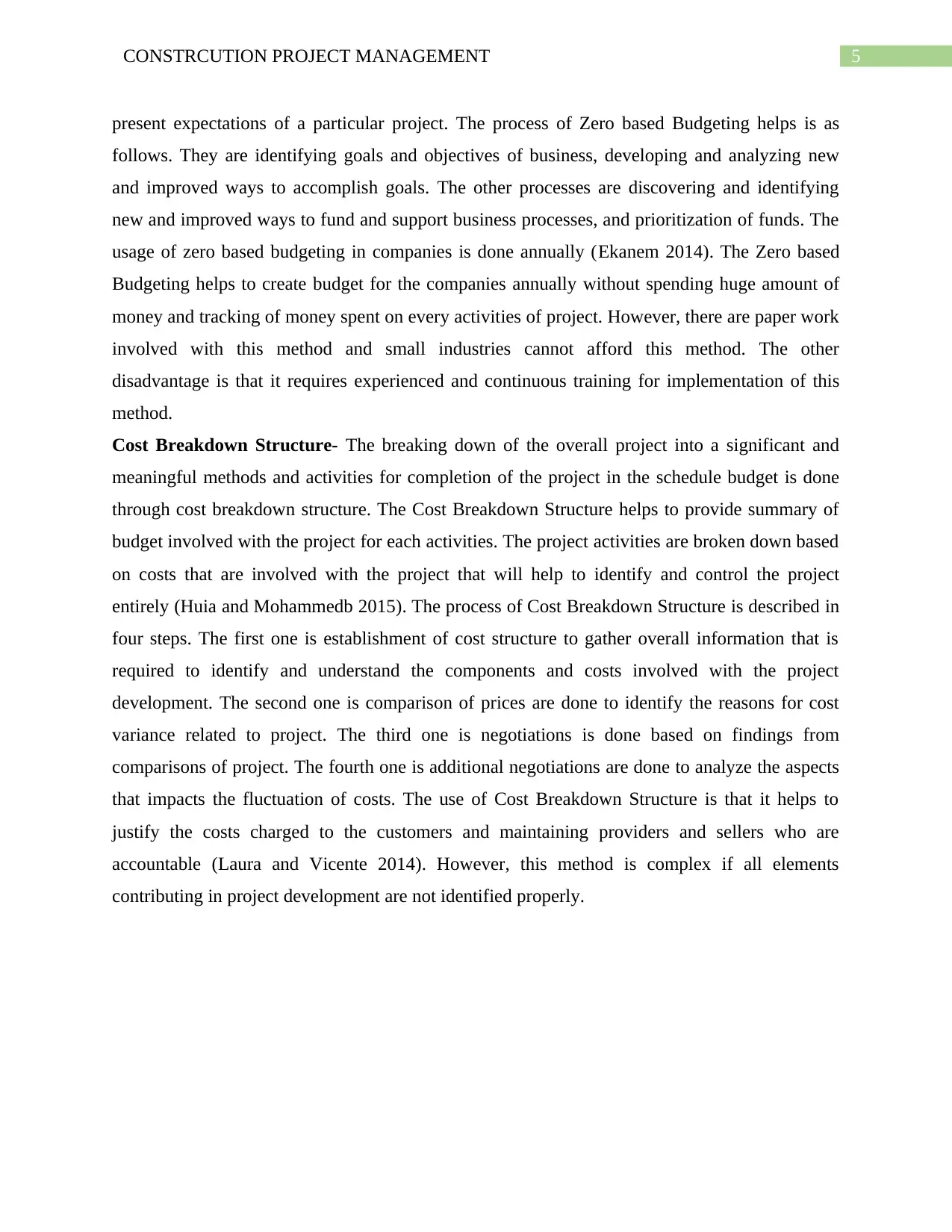
5CONSTRCUTION PROJECT MANAGEMENT
present expectations of a particular project. The process of Zero based Budgeting helps is as
follows. They are identifying goals and objectives of business, developing and analyzing new
and improved ways to accomplish goals. The other processes are discovering and identifying
new and improved ways to fund and support business processes, and prioritization of funds. The
usage of zero based budgeting in companies is done annually (Ekanem 2014). The Zero based
Budgeting helps to create budget for the companies annually without spending huge amount of
money and tracking of money spent on every activities of project. However, there are paper work
involved with this method and small industries cannot afford this method. The other
disadvantage is that it requires experienced and continuous training for implementation of this
method.
Cost Breakdown Structure- The breaking down of the overall project into a significant and
meaningful methods and activities for completion of the project in the schedule budget is done
through cost breakdown structure. The Cost Breakdown Structure helps to provide summary of
budget involved with the project for each activities. The project activities are broken down based
on costs that are involved with the project that will help to identify and control the project
entirely (Huia and Mohammedb 2015). The process of Cost Breakdown Structure is described in
four steps. The first one is establishment of cost structure to gather overall information that is
required to identify and understand the components and costs involved with the project
development. The second one is comparison of prices are done to identify the reasons for cost
variance related to project. The third one is negotiations is done based on findings from
comparisons of project. The fourth one is additional negotiations are done to analyze the aspects
that impacts the fluctuation of costs. The use of Cost Breakdown Structure is that it helps to
justify the costs charged to the customers and maintaining providers and sellers who are
accountable (Laura and Vicente 2014). However, this method is complex if all elements
contributing in project development are not identified properly.
present expectations of a particular project. The process of Zero based Budgeting helps is as
follows. They are identifying goals and objectives of business, developing and analyzing new
and improved ways to accomplish goals. The other processes are discovering and identifying
new and improved ways to fund and support business processes, and prioritization of funds. The
usage of zero based budgeting in companies is done annually (Ekanem 2014). The Zero based
Budgeting helps to create budget for the companies annually without spending huge amount of
money and tracking of money spent on every activities of project. However, there are paper work
involved with this method and small industries cannot afford this method. The other
disadvantage is that it requires experienced and continuous training for implementation of this
method.
Cost Breakdown Structure- The breaking down of the overall project into a significant and
meaningful methods and activities for completion of the project in the schedule budget is done
through cost breakdown structure. The Cost Breakdown Structure helps to provide summary of
budget involved with the project for each activities. The project activities are broken down based
on costs that are involved with the project that will help to identify and control the project
entirely (Huia and Mohammedb 2015). The process of Cost Breakdown Structure is described in
four steps. The first one is establishment of cost structure to gather overall information that is
required to identify and understand the components and costs involved with the project
development. The second one is comparison of prices are done to identify the reasons for cost
variance related to project. The third one is negotiations is done based on findings from
comparisons of project. The fourth one is additional negotiations are done to analyze the aspects
that impacts the fluctuation of costs. The use of Cost Breakdown Structure is that it helps to
justify the costs charged to the customers and maintaining providers and sellers who are
accountable (Laura and Vicente 2014). However, this method is complex if all elements
contributing in project development are not identified properly.
⊘ This is a preview!⊘
Do you want full access?
Subscribe today to unlock all pages.

Trusted by 1+ million students worldwide
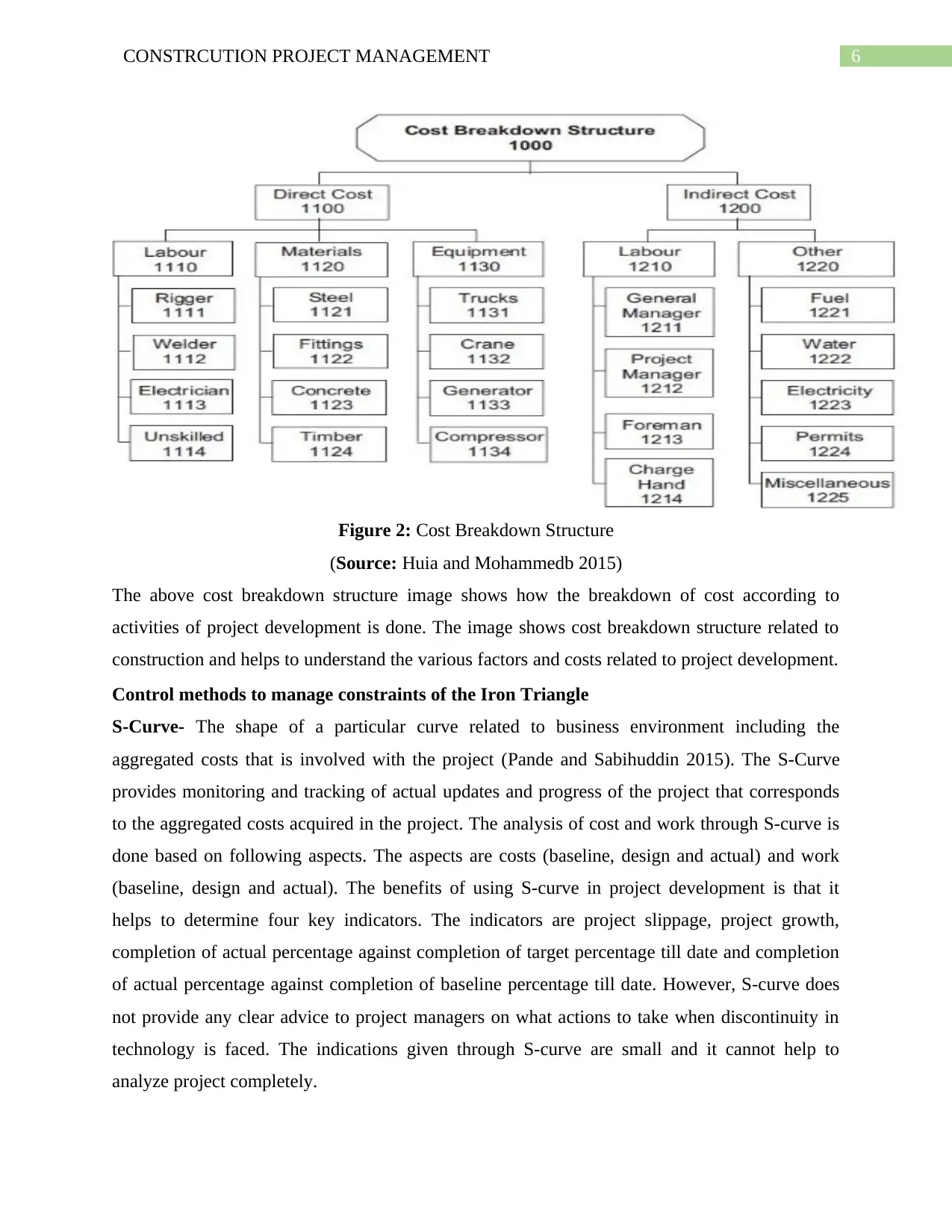
6CONSTRCUTION PROJECT MANAGEMENT
Figure 2: Cost Breakdown Structure
(Source: Huia and Mohammedb 2015)
The above cost breakdown structure image shows how the breakdown of cost according to
activities of project development is done. The image shows cost breakdown structure related to
construction and helps to understand the various factors and costs related to project development.
Control methods to manage constraints of the Iron Triangle
S-Curve- The shape of a particular curve related to business environment including the
aggregated costs that is involved with the project (Pande and Sabihuddin 2015). The S-Curve
provides monitoring and tracking of actual updates and progress of the project that corresponds
to the aggregated costs acquired in the project. The analysis of cost and work through S-curve is
done based on following aspects. The aspects are costs (baseline, design and actual) and work
(baseline, design and actual). The benefits of using S-curve in project development is that it
helps to determine four key indicators. The indicators are project slippage, project growth,
completion of actual percentage against completion of target percentage till date and completion
of actual percentage against completion of baseline percentage till date. However, S-curve does
not provide any clear advice to project managers on what actions to take when discontinuity in
technology is faced. The indications given through S-curve are small and it cannot help to
analyze project completely.
Figure 2: Cost Breakdown Structure
(Source: Huia and Mohammedb 2015)
The above cost breakdown structure image shows how the breakdown of cost according to
activities of project development is done. The image shows cost breakdown structure related to
construction and helps to understand the various factors and costs related to project development.
Control methods to manage constraints of the Iron Triangle
S-Curve- The shape of a particular curve related to business environment including the
aggregated costs that is involved with the project (Pande and Sabihuddin 2015). The S-Curve
provides monitoring and tracking of actual updates and progress of the project that corresponds
to the aggregated costs acquired in the project. The analysis of cost and work through S-curve is
done based on following aspects. The aspects are costs (baseline, design and actual) and work
(baseline, design and actual). The benefits of using S-curve in project development is that it
helps to determine four key indicators. The indicators are project slippage, project growth,
completion of actual percentage against completion of target percentage till date and completion
of actual percentage against completion of baseline percentage till date. However, S-curve does
not provide any clear advice to project managers on what actions to take when discontinuity in
technology is faced. The indications given through S-curve are small and it cannot help to
analyze project completely.
Paraphrase This Document
Need a fresh take? Get an instant paraphrase of this document with our AI Paraphraser
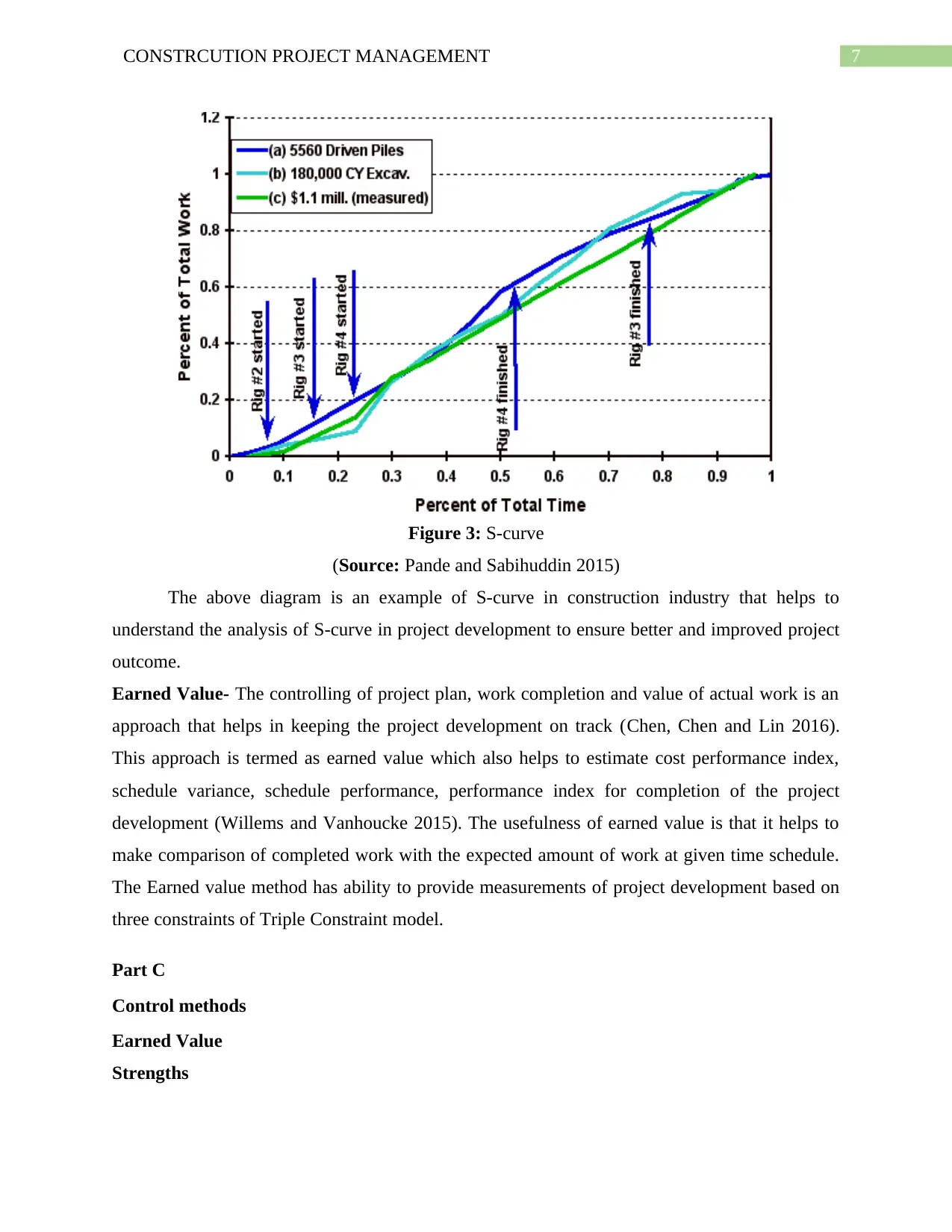
7CONSTRCUTION PROJECT MANAGEMENT
Figure 3: S-curve
(Source: Pande and Sabihuddin 2015)
The above diagram is an example of S-curve in construction industry that helps to
understand the analysis of S-curve in project development to ensure better and improved project
outcome.
Earned Value- The controlling of project plan, work completion and value of actual work is an
approach that helps in keeping the project development on track (Chen, Chen and Lin 2016).
This approach is termed as earned value which also helps to estimate cost performance index,
schedule variance, schedule performance, performance index for completion of the project
development (Willems and Vanhoucke 2015). The usefulness of earned value is that it helps to
make comparison of completed work with the expected amount of work at given time schedule.
The Earned value method has ability to provide measurements of project development based on
three constraints of Triple Constraint model.
Part C
Control methods
Earned Value
Strengths
Figure 3: S-curve
(Source: Pande and Sabihuddin 2015)
The above diagram is an example of S-curve in construction industry that helps to
understand the analysis of S-curve in project development to ensure better and improved project
outcome.
Earned Value- The controlling of project plan, work completion and value of actual work is an
approach that helps in keeping the project development on track (Chen, Chen and Lin 2016).
This approach is termed as earned value which also helps to estimate cost performance index,
schedule variance, schedule performance, performance index for completion of the project
development (Willems and Vanhoucke 2015). The usefulness of earned value is that it helps to
make comparison of completed work with the expected amount of work at given time schedule.
The Earned value method has ability to provide measurements of project development based on
three constraints of Triple Constraint model.
Part C
Control methods
Earned Value
Strengths
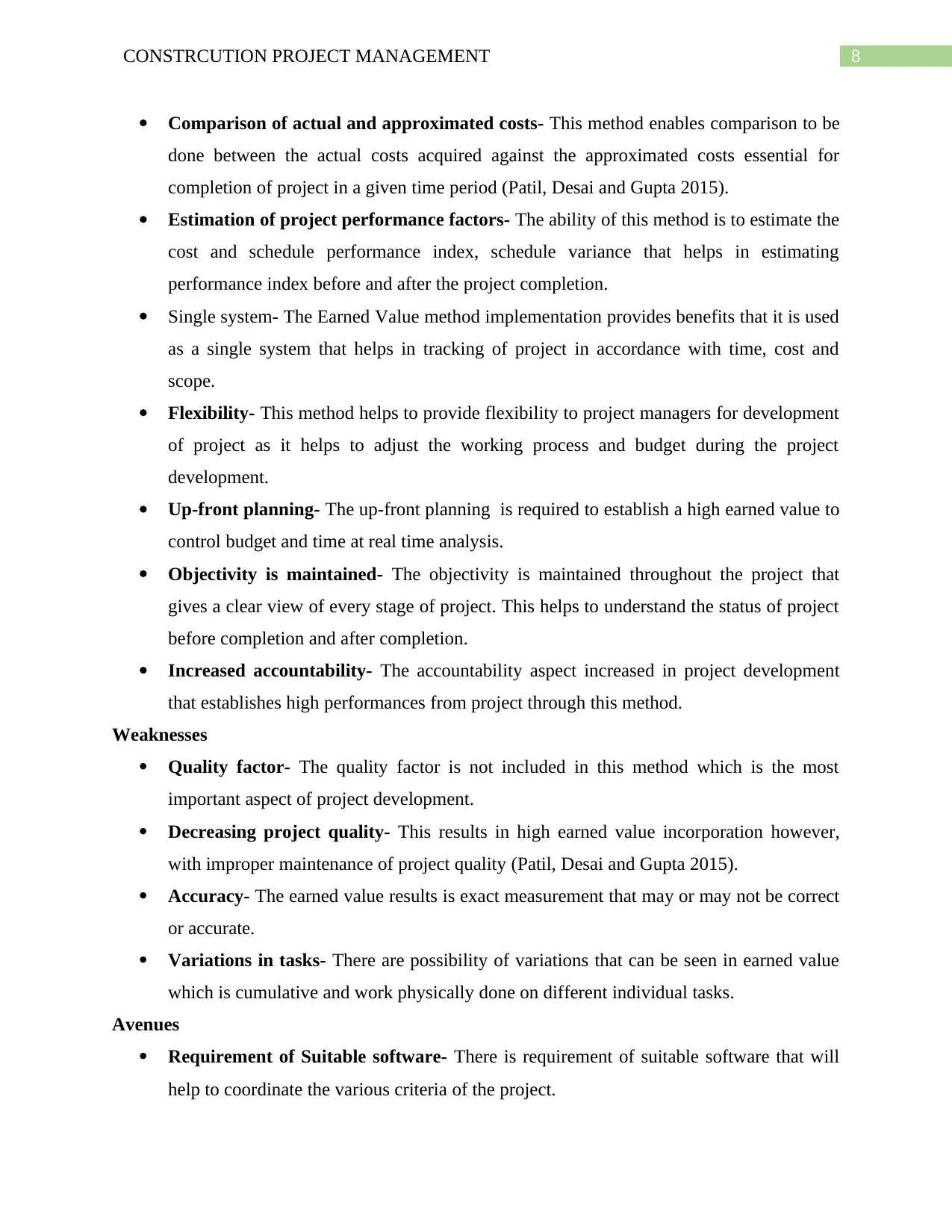
8CONSTRCUTION PROJECT MANAGEMENT
Comparison of actual and approximated costs- This method enables comparison to be
done between the actual costs acquired against the approximated costs essential for
completion of project in a given time period (Patil, Desai and Gupta 2015).
Estimation of project performance factors- The ability of this method is to estimate the
cost and schedule performance index, schedule variance that helps in estimating
performance index before and after the project completion.
Single system- The Earned Value method implementation provides benefits that it is used
as a single system that helps in tracking of project in accordance with time, cost and
scope.
Flexibility- This method helps to provide flexibility to project managers for development
of project as it helps to adjust the working process and budget during the project
development.
Up-front planning- The up-front planning is required to establish a high earned value to
control budget and time at real time analysis.
Objectivity is maintained- The objectivity is maintained throughout the project that
gives a clear view of every stage of project. This helps to understand the status of project
before completion and after completion.
Increased accountability- The accountability aspect increased in project development
that establishes high performances from project through this method.
Weaknesses
Quality factor- The quality factor is not included in this method which is the most
important aspect of project development.
Decreasing project quality- This results in high earned value incorporation however,
with improper maintenance of project quality (Patil, Desai and Gupta 2015).
Accuracy- The earned value results is exact measurement that may or may not be correct
or accurate.
Variations in tasks- There are possibility of variations that can be seen in earned value
which is cumulative and work physically done on different individual tasks.
Avenues
Requirement of Suitable software- There is requirement of suitable software that will
help to coordinate the various criteria of the project.
Comparison of actual and approximated costs- This method enables comparison to be
done between the actual costs acquired against the approximated costs essential for
completion of project in a given time period (Patil, Desai and Gupta 2015).
Estimation of project performance factors- The ability of this method is to estimate the
cost and schedule performance index, schedule variance that helps in estimating
performance index before and after the project completion.
Single system- The Earned Value method implementation provides benefits that it is used
as a single system that helps in tracking of project in accordance with time, cost and
scope.
Flexibility- This method helps to provide flexibility to project managers for development
of project as it helps to adjust the working process and budget during the project
development.
Up-front planning- The up-front planning is required to establish a high earned value to
control budget and time at real time analysis.
Objectivity is maintained- The objectivity is maintained throughout the project that
gives a clear view of every stage of project. This helps to understand the status of project
before completion and after completion.
Increased accountability- The accountability aspect increased in project development
that establishes high performances from project through this method.
Weaknesses
Quality factor- The quality factor is not included in this method which is the most
important aspect of project development.
Decreasing project quality- This results in high earned value incorporation however,
with improper maintenance of project quality (Patil, Desai and Gupta 2015).
Accuracy- The earned value results is exact measurement that may or may not be correct
or accurate.
Variations in tasks- There are possibility of variations that can be seen in earned value
which is cumulative and work physically done on different individual tasks.
Avenues
Requirement of Suitable software- There is requirement of suitable software that will
help to coordinate the various criteria of the project.
⊘ This is a preview!⊘
Do you want full access?
Subscribe today to unlock all pages.

Trusted by 1+ million students worldwide
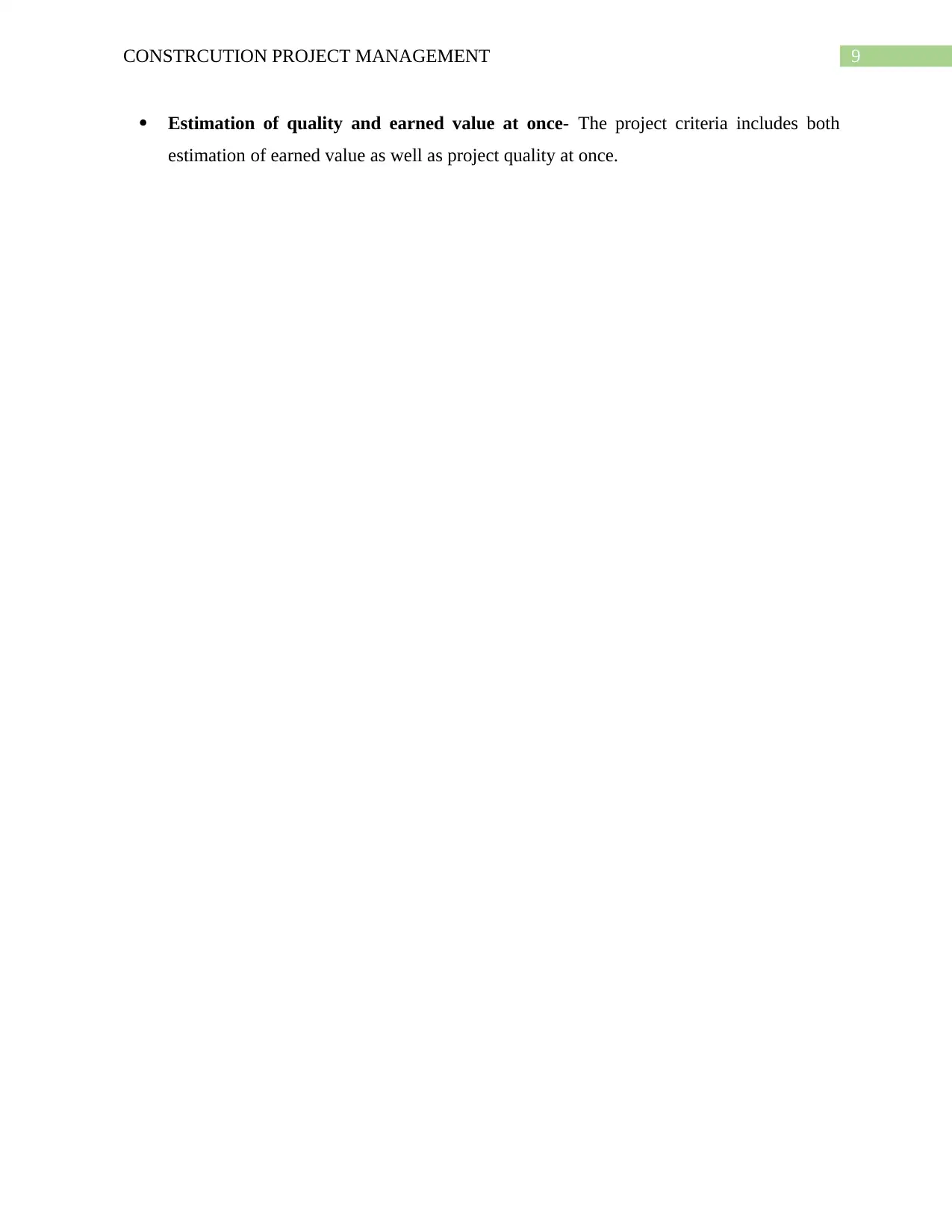
9CONSTRCUTION PROJECT MANAGEMENT
Estimation of quality and earned value at once- The project criteria includes both
estimation of earned value as well as project quality at once.
Estimation of quality and earned value at once- The project criteria includes both
estimation of earned value as well as project quality at once.
Paraphrase This Document
Need a fresh take? Get an instant paraphrase of this document with our AI Paraphraser
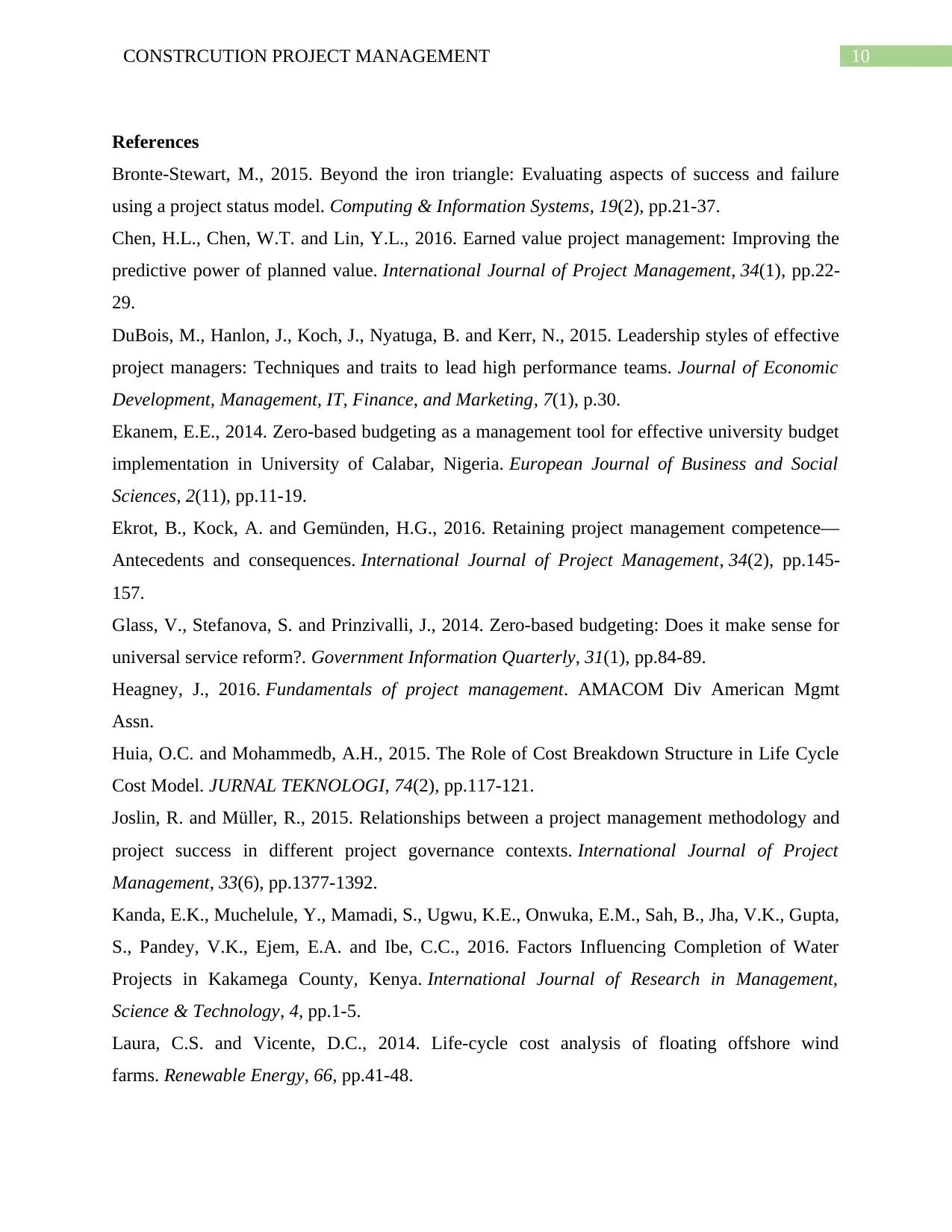
10CONSTRCUTION PROJECT MANAGEMENT
References
Bronte-Stewart, M., 2015. Beyond the iron triangle: Evaluating aspects of success and failure
using a project status model. Computing & Information Systems, 19(2), pp.21-37.
Chen, H.L., Chen, W.T. and Lin, Y.L., 2016. Earned value project management: Improving the
predictive power of planned value. International Journal of Project Management, 34(1), pp.22-
29.
DuBois, M., Hanlon, J., Koch, J., Nyatuga, B. and Kerr, N., 2015. Leadership styles of effective
project managers: Techniques and traits to lead high performance teams. Journal of Economic
Development, Management, IT, Finance, and Marketing, 7(1), p.30.
Ekanem, E.E., 2014. Zero-based budgeting as a management tool for effective university budget
implementation in University of Calabar, Nigeria. European Journal of Business and Social
Sciences, 2(11), pp.11-19.
Ekrot, B., Kock, A. and Gemünden, H.G., 2016. Retaining project management competence—
Antecedents and consequences. International Journal of Project Management, 34(2), pp.145-
157.
Glass, V., Stefanova, S. and Prinzivalli, J., 2014. Zero-based budgeting: Does it make sense for
universal service reform?. Government Information Quarterly, 31(1), pp.84-89.
Heagney, J., 2016. Fundamentals of project management. AMACOM Div American Mgmt
Assn.
Huia, O.C. and Mohammedb, A.H., 2015. The Role of Cost Breakdown Structure in Life Cycle
Cost Model. JURNAL TEKNOLOGI, 74(2), pp.117-121.
Joslin, R. and Müller, R., 2015. Relationships between a project management methodology and
project success in different project governance contexts. International Journal of Project
Management, 33(6), pp.1377-1392.
Kanda, E.K., Muchelule, Y., Mamadi, S., Ugwu, K.E., Onwuka, E.M., Sah, B., Jha, V.K., Gupta,
S., Pandey, V.K., Ejem, E.A. and Ibe, C.C., 2016. Factors Influencing Completion of Water
Projects in Kakamega County, Kenya. International Journal of Research in Management,
Science & Technology, 4, pp.1-5.
Laura, C.S. and Vicente, D.C., 2014. Life-cycle cost analysis of floating offshore wind
farms. Renewable Energy, 66, pp.41-48.
References
Bronte-Stewart, M., 2015. Beyond the iron triangle: Evaluating aspects of success and failure
using a project status model. Computing & Information Systems, 19(2), pp.21-37.
Chen, H.L., Chen, W.T. and Lin, Y.L., 2016. Earned value project management: Improving the
predictive power of planned value. International Journal of Project Management, 34(1), pp.22-
29.
DuBois, M., Hanlon, J., Koch, J., Nyatuga, B. and Kerr, N., 2015. Leadership styles of effective
project managers: Techniques and traits to lead high performance teams. Journal of Economic
Development, Management, IT, Finance, and Marketing, 7(1), p.30.
Ekanem, E.E., 2014. Zero-based budgeting as a management tool for effective university budget
implementation in University of Calabar, Nigeria. European Journal of Business and Social
Sciences, 2(11), pp.11-19.
Ekrot, B., Kock, A. and Gemünden, H.G., 2016. Retaining project management competence—
Antecedents and consequences. International Journal of Project Management, 34(2), pp.145-
157.
Glass, V., Stefanova, S. and Prinzivalli, J., 2014. Zero-based budgeting: Does it make sense for
universal service reform?. Government Information Quarterly, 31(1), pp.84-89.
Heagney, J., 2016. Fundamentals of project management. AMACOM Div American Mgmt
Assn.
Huia, O.C. and Mohammedb, A.H., 2015. The Role of Cost Breakdown Structure in Life Cycle
Cost Model. JURNAL TEKNOLOGI, 74(2), pp.117-121.
Joslin, R. and Müller, R., 2015. Relationships between a project management methodology and
project success in different project governance contexts. International Journal of Project
Management, 33(6), pp.1377-1392.
Kanda, E.K., Muchelule, Y., Mamadi, S., Ugwu, K.E., Onwuka, E.M., Sah, B., Jha, V.K., Gupta,
S., Pandey, V.K., Ejem, E.A. and Ibe, C.C., 2016. Factors Influencing Completion of Water
Projects in Kakamega County, Kenya. International Journal of Research in Management,
Science & Technology, 4, pp.1-5.
Laura, C.S. and Vicente, D.C., 2014. Life-cycle cost analysis of floating offshore wind
farms. Renewable Energy, 66, pp.41-48.
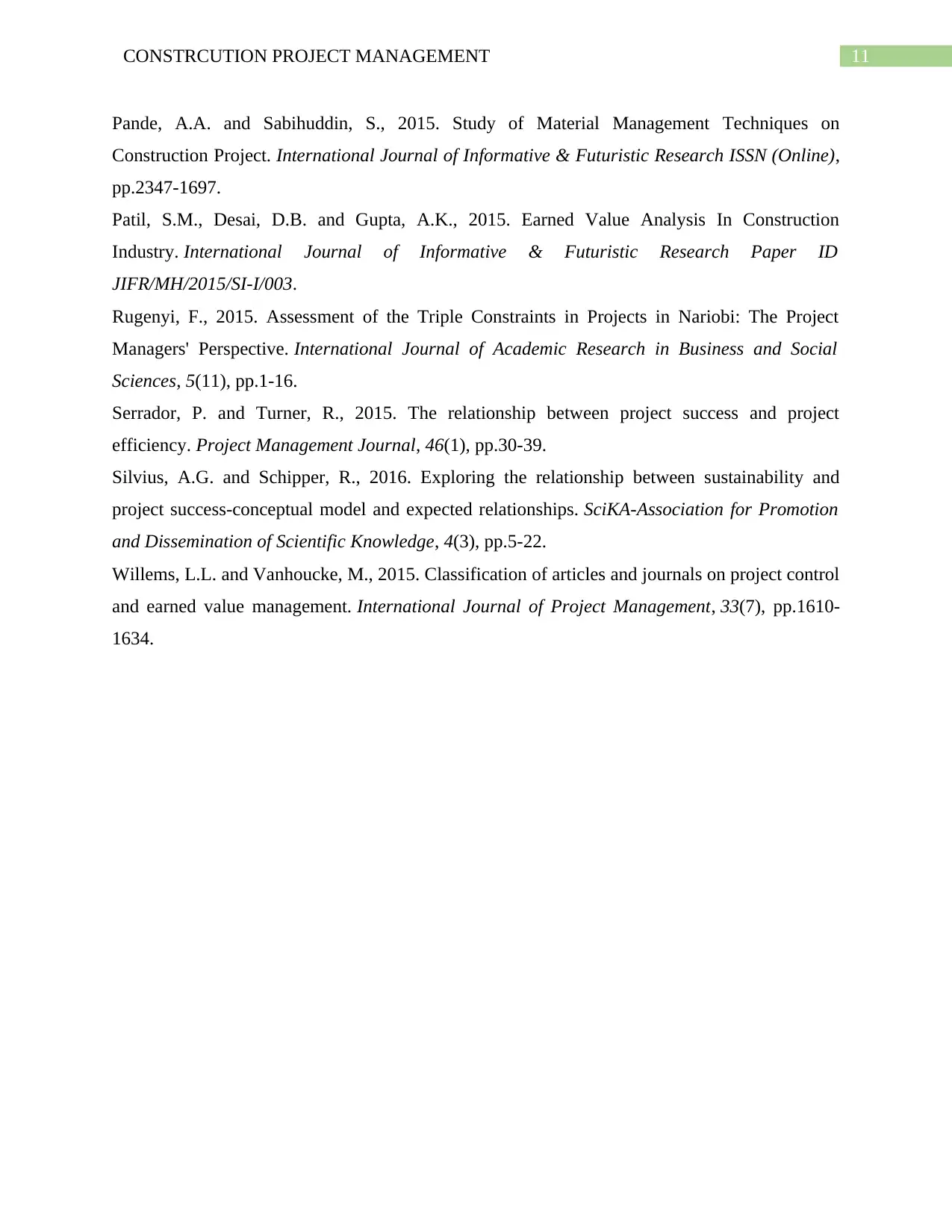
11CONSTRCUTION PROJECT MANAGEMENT
Pande, A.A. and Sabihuddin, S., 2015. Study of Material Management Techniques on
Construction Project. International Journal of Informative & Futuristic Research ISSN (Online),
pp.2347-1697.
Patil, S.M., Desai, D.B. and Gupta, A.K., 2015. Earned Value Analysis In Construction
Industry. International Journal of Informative & Futuristic Research Paper ID
JIFR/MH/2015/SI-I/003.
Rugenyi, F., 2015. Assessment of the Triple Constraints in Projects in Nariobi: The Project
Managers' Perspective. International Journal of Academic Research in Business and Social
Sciences, 5(11), pp.1-16.
Serrador, P. and Turner, R., 2015. The relationship between project success and project
efficiency. Project Management Journal, 46(1), pp.30-39.
Silvius, A.G. and Schipper, R., 2016. Exploring the relationship between sustainability and
project success-conceptual model and expected relationships. SciKA-Association for Promotion
and Dissemination of Scientific Knowledge, 4(3), pp.5-22.
Willems, L.L. and Vanhoucke, M., 2015. Classification of articles and journals on project control
and earned value management. International Journal of Project Management, 33(7), pp.1610-
1634.
Pande, A.A. and Sabihuddin, S., 2015. Study of Material Management Techniques on
Construction Project. International Journal of Informative & Futuristic Research ISSN (Online),
pp.2347-1697.
Patil, S.M., Desai, D.B. and Gupta, A.K., 2015. Earned Value Analysis In Construction
Industry. International Journal of Informative & Futuristic Research Paper ID
JIFR/MH/2015/SI-I/003.
Rugenyi, F., 2015. Assessment of the Triple Constraints in Projects in Nariobi: The Project
Managers' Perspective. International Journal of Academic Research in Business and Social
Sciences, 5(11), pp.1-16.
Serrador, P. and Turner, R., 2015. The relationship between project success and project
efficiency. Project Management Journal, 46(1), pp.30-39.
Silvius, A.G. and Schipper, R., 2016. Exploring the relationship between sustainability and
project success-conceptual model and expected relationships. SciKA-Association for Promotion
and Dissemination of Scientific Knowledge, 4(3), pp.5-22.
Willems, L.L. and Vanhoucke, M., 2015. Classification of articles and journals on project control
and earned value management. International Journal of Project Management, 33(7), pp.1610-
1634.
⊘ This is a preview!⊘
Do you want full access?
Subscribe today to unlock all pages.

Trusted by 1+ million students worldwide
1 out of 12
Related Documents
Your All-in-One AI-Powered Toolkit for Academic Success.
+13062052269
info@desklib.com
Available 24*7 on WhatsApp / Email
![[object Object]](/_next/static/media/star-bottom.7253800d.svg)
Unlock your academic potential
Copyright © 2020–2025 A2Z Services. All Rights Reserved. Developed and managed by ZUCOL.





